Anyone who remembers Iran in the 1950s and 1960s can attest that it was an era marked by severe repression against the dissidents and political activists. After conducting the 1953 coup against Dr. Mohammad Mossadegh, Iran’s popular Prime Minister who nationalized the country’s oil industry, Shah Mohammad Reza Pahlavi, Iran’s monarch, had forced all opposition groups and movements into silence and submission. Through his brutal secret police, the Savak, Pahlavi had established an iron-fisted rule.
The first members of PMOI/MEK hail from circles of young intellectuals and academics
It was under these circumstances that on September 6, 1965, three Iranian intellectuals, Mohammad Hanifnejad, Saeid Mohsen and Ali Asghar Badizadegan, founded a new opposition movement that later became the People’s Mojahedin Organization of Iran (PMOI/MEK), the principal and longest-standing Iranian opposition movement. The trio were inspired by the authentic interpretation of Islam that rejects all forms of fundamentalism, which had previously been the dominant interpretation of the religion in Iran and set severe social and political restrictions on people, their freedoms and their right to express their beliefs.
Since its founding, the PMOI/MEK was opposed to the atheist/Muslim conflict that the fundamentalist mullahs of Iran were promoting. Hanifnejad and the other founders of the MEK stressed that the real conflict was not between faiths but between the tyrants (the Shah regime) and the oppressed (the people of Iran, regardless of their faith and ethnicity).
Staying true to these principles, which were unprecedented in the Iranian history, the founders of the MEK embarked on a long journey to establish freedom and democracy in their country. And they paid a heavy price to defend the rights of their people, setting an example of persistence and loyalty that is still admired by Iranians across the globe to this day.
1965-1969: The beginnings of the MEK
From 1965 to 1969, the founders of the MEK were focused on recruiting new members and creating a network of elite cadres that could lead the movement through the hard times that would come. Their conviction was that the struggle for freedom is a science, and they must study it and acquire it to be able to succeed where their predecessors had failed. To this end, they engaged in thorough studies of all philosophies and doctrines to glean everything that could help in their struggle. After thorough examination and studies, Hanifnejad and his comrades eventually chose democratic Islam as the ideology that could best serve the aspirations of the Iranian people.
The founders of the MEK had also concluded that the fight for freedom and democracy can’t be a part-time job that one engages in during their free time. That’s why they were focused on recruiting people who were willing to dedicate their every hour to help advance the organization’s goals. The first people to join the movement were young intellectuals and university students. Among them was Massoud Rajavi, a young student who would later become pivotal in shaping the organization’s future.
1971: The crackdown on the MEK and the execution of its leaders
During the winter of 1969, the PMOI/MEK started to form a network of activists that could start taking concrete action against the Shah regime.
In August 1971, while the Iranian monarchy was preparing for its much-advertised festivities to celebrate its longtime rule, the Shah ordered a widespread crackdown on all opposition groups and individuals that could prove problematic to the ceremonies, in which several head of states were scheduled to attend.
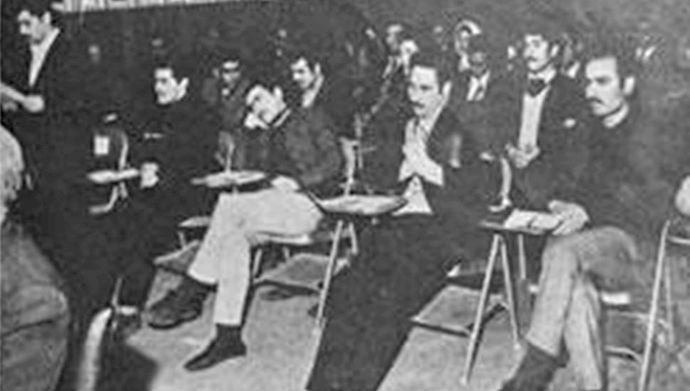
The members and leaders of PMOI/MEK become widely known in society for their defense in the military courts of Shah, in which they defy the ruling power and its corruption
Subsequently, the Savak arrested and incarcerated more than 80 percent of MEK’s members, including all of its leaders. This was a very hard strike against the nascent organization, but it also leads to the recognition and popularity of the MEK among the Iranian people. The defenses of the MEK’s leaders in the Shah’s military courts, in which they defied the regime’s power and exposed its corruption, became especially popular among the Iranian masses, who were directly feeling the oppression of the Shah regime in their daily lives.
The stories of the MEK’s resistance in Shah’s prisons and courts circulated among Iranians by word of mouth, and soon the organization managed to garner a solid and widespread base of support in the Iranian society, among all walks of life.
Hoping to defuse the growing threat of the MEK for its regime, the Savak proposed to Mohammad Hanifnejad, who had been sentenced to death, to publicly repent his struggle to avoid execution. Hanifnejad and the other leaders of the MEK refused to turn their back on their ideals and their dreams for freedom and democracy, for which they made the ultimate sacrifice. On May 25, 1972, Shah’s regime executed Mohammad Hanifnejad, Saeid Mohsen and Ali Asghar Badizadegan.
Of all the leading members of the MEK, only Massoud Rajavi was spared. He was saved from imminent death thanks to an international campaign by his brother, Kazem Rajavi. Kazem, who was a renowned jurist and politician in Switzerland, rallied several organizations and politicians to intervene and pressurize the Shah regime to revoke Massoud’s death sentence. Among those politicians was Francois Mitterrand, the leader of the French Socialist Party and the future-to-be President of France. Under heavy international pressure, the Shah regime was forced to reduce Massoud’s sentence from death to life in prison.
1975: A failed coup within the ranks of the MEK
In September 1975, the MEK was still recovering in the after the Shah dictatorship executed most of its leadership cadre. Of the elite members of the MEK, only Massoud Rajavi remained, and he was isolated in the dungeons of the Shah. During this period, a separatist Maoist group tried to change the ideology of the MEK and hijack its name and emblem.
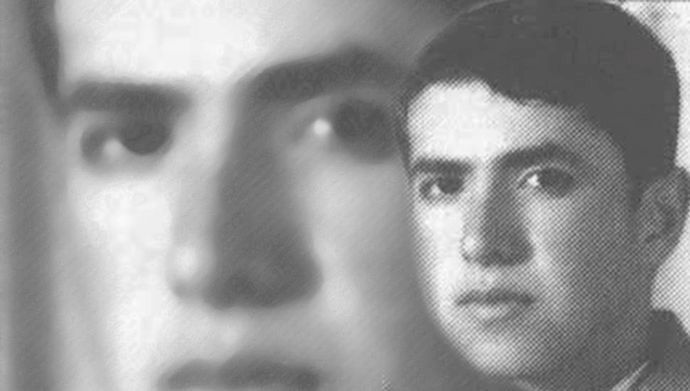
Majid Sharif Vaghefi, a senior member of the PMOI/MEK, assassinated by separatists in 1975
To drive its point and further its goal, the separatist group went as far as intimidating and oppressing MEK members who remained loyal to the organization’s true mindset and ideology. The separatists murdered Majid Sharif Vaghefi, one of the senior members of the MEK outside of prison who refused to accept their twisted ideology.
The turmoil virtually tore the MEK apart, and it was only thanks to the efforts of Massoud Rajavi that the organization was brought back from the brink. Massoud issued a 12-point declaration in the fall of 1976, in which he reasserted the true foundations of the MEK’s ideology and its principles. The declaration became the basis for all the members of the organization to stay true to the organization’s aspirations and goals.
The 1979 revolution
In the final years of the 1970s, a series of escalating nationwide protests started chipping away at the power of the Shah regime, which previously exuded absolute control over the country. The regime started to yield under the pressure of the demonstrators, who demanded political freedoms and the release of political prisoners.
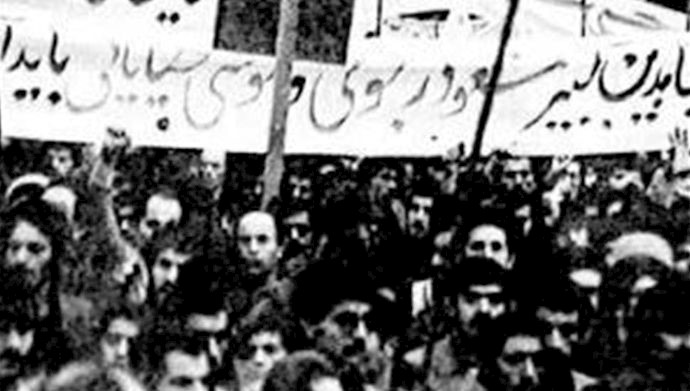
A banner brandished during the 1978 anti-monarchist demonstrations calling for the release of political prisoners, including Massoud Rajavi and Moussa Khiabani
On January 20, 1979, Massoud Rajavi and other leading members of the MEK were released from Shah’s prisons. The MEK then assumed an active role in the protests that shaped the 1979 revolution, whose slogans were the very things the MEK had fought for since its founding and its members had made sacrifices for. Merely a month later, the monarchy collapsed, and a new era began in Iran. Since the Mojahedin had spent most of the months that led to the 1979 revolution in prison, the mullahs, under the guidance of Ruhollah Khomeini, took advantage of the vacuum to take control of the situation and seize the country’s power.
1979-1981: Peaceful protest against the religious fascism of the mullahs
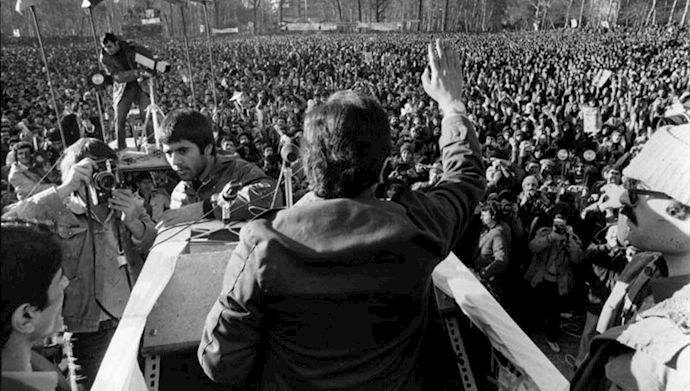
Less than two years after the 1979 Revolution, the PMOI/MEK become the largest political movement in Iran (Massoud Rajavis speech at the University of Tehran)
Since the rise to power of Ayatollah Ruhollah Khomeini, the founder of the fundamentalist dictatorship, the MEK constantly warned against the abuses of the new regime, including the repression of women, minorities and all opposition forces. As the main defender of freedoms, the MEK quickly built up an expanding base of support in the Iranian population, especially among young people and intellectuals. In less than two years, MEK became the largest political movement in Iran.
However, during these two years, Khomeini’s regime continued to sink the country in a merciless religious dictatorship that spared neither women, nor students, nor minorities. In the same period, Khomeini’s henchmen murdered 70 members and supporters of the MEK during peaceful rallies, meetings, and protests.
On June 20, 1981, the MEK tested the democratic environment a final time by launching a demonstration to remind the Khomeini regime of its responsibilities to respect the fundamental freedoms of the Iranian people. In Tehran, more than 500 thousand people attended the demonstration, which hadn’t been publicly declared in advance.
In response, Khomeini ordered the Revolutionary Guards (IRGC), his personal army, to open fire on the unarmed and peaceful protesters.
Post-1981: The dark terror of the Khomeini regime and the founding of the NCRI
On the morrow of the June 20 demonstration, the Iranian regime launched a ruthless crackdown against all opposition forces, especially the supporters and members of the MEK. The regime’s forces chased and executed many of the Mojahedin’s members in the streets, and thousands were dragged into the regime’s prisons, where they were subjected to inhuman tortures and were later executed. Women, children, elderly—no one was spared.
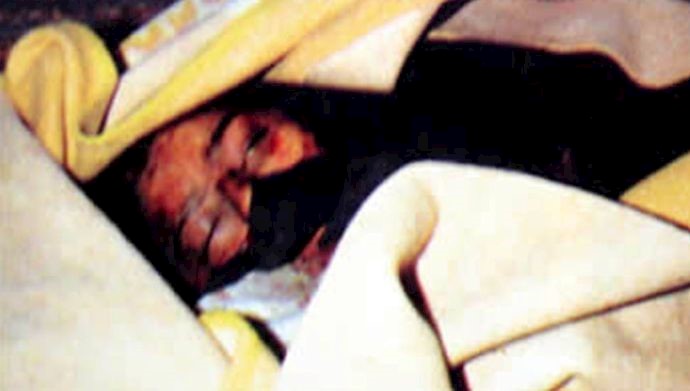
The regime’s executioners did not spare women, children, or elderly—photo of a young, 18-year-old MEK member shot after being tortured (1981
Following the banning of all opposition forces, the Khomeini regime executed and murdered some 120 thousand people, most of whom were affiliated with the MEK. In Khomeini’s prisons, his guards and executioners resorted to the most vile and brutal tortures. Khomeini’s fatwas give his torturers free rein to do anything they want to torment the Mojahedin, including rape, severing body organs, gouging eyes, etc. On some accounts, the regime’s guards extracted the blood of MEK members before executing them so they could use it for the own medical needs of their own guards and soldiers. Pregnant women were tortured and executed. Young girls were raped before their execution. These are just some of the brutalities that the Iranian regime imposed on MEK prisoners.
Under these circumstances, on July 21, 1981, a month after the beginning of Khomeini’s reign of terror, Massoud Rajavi founded the National Council of Resistance of Iran (NCRI), a coalition of all opposition forces that aspired for replacing the religious fascism of Khomeini with a democratic, pluralist and secular state. A week later, on July 29, the leaders of the MEK exited Iran with help from the brave and freedom-loving officers of the Iranian Air Force. Rajavi took refuge in France, from where he continued to lead the struggle for freedom against the Iranian regime.
The MEK and the Iran-Iraq war
In 1980, when the Iraqi army occupied parts of the Iranian soil, the MEK were quick to take up arms and defend their homeland. But as soon as the Iraqi army released its hold on Iranian land and retreated back behind international borders, the continuation of the war was no longer justified and the Mojahedin were also quick to call for peace between the two countries. Meanwhile, Khomeini insisted on continuing the war until the overthrow of the Iraqi government and the establishment of another religious tyranny identical to his own in the neighboring country. The war provided Khomeini with the perfect pretext to suppress the demands of the people under the excuse of being at war and cracking down on all opposition forces by accusing them of weakening the government and colluding with foreign enemies.
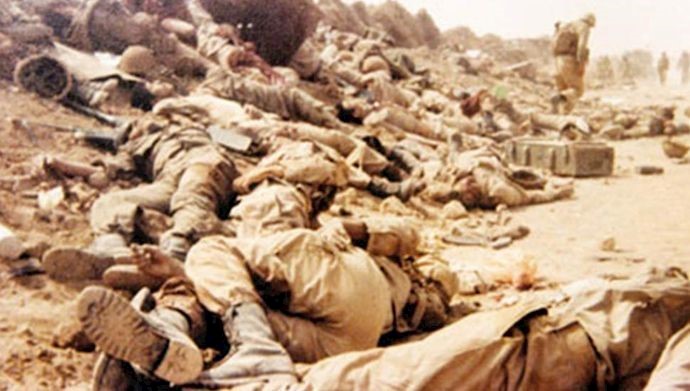
Iran-Iraq war kills millions on both sides, while peace is achievable
On September 10, 1982, Massoud Rajavi met with then–Iraqi Foreign Minister Tariq Aziz in the NCRI’s Paris headquarters and signed a peace agreement with the Iraqi government on behalf of the MEK and the Iranian people. The move proved that peace can be achieved, and it’s the Iranian regime’s fault that the war is being prolonged.
The MEK’s peace effort quickly garnered international recognition and support and was endorsed by 5,000 politicians from 57 countries worldwide.
1985: The rise of women in leadership roles in MEK
In the six years that had followed the 1979 revolution, the female members of the MEK had proven that women were at the forefront of the all-out resistance against the religious and misogynistic rule of Khomeini. Eventually, on March 10, 1985, women found their true place in the ranks of the Mojahedin when Maryam Azdanlou (Rajavi) became the co-secretary general of the organization.

On March 10, 1985, Maryam Azdanlou (Rajavi) is named co-leader of the PMOI/MEK
The event marked a turning point in the history of the Mojahedin in its struggle against the fundamentalist ideology of Khomeini, which was especially harsh toward Iranian women. It was the conviction of the Mojahedin that if women are the primary victims of the Iranian regime, then they should be given a privileged status in the MEK’s ranks, which is the nemesis of the mullahs’ rule in every way.
1986: MEK relocates to Iraq
On June 7, 1986, under pressure from the French government, which was deeply engaged in dealings with the Iranian regime, Massoud Rajavi left France for Iraq, where he founded the National Liberation Army (NLA) on June 20, 1987. The NLA became a major force against the Iranian regime.

The Iranian National Liberation Army (NLA), in which women play an active role, has carried out a hundred assaults against the Khomeini armed forces
The MEK predicated its installment in Iraq on preserving its independence and the non-interference of Baghdad in the politics and operations of the Iranian Resistance, a condition that was agreed upon in bilateral negotiations with the Iraqi government.
The NLA engaged in hundreds of assaults against the military of the Iranian regime. On July 25, 1988, the NLA launched its largest operation, called “Eternal Light,” in which it targeted the entirety of the Iranian regime. The Iranian regime suffered 55,000 casualties, and on its part, the NLA lost 1,304 of its officers and soldiers, heroes who laid down their lives for the freedom of their country.
Middle East analysts and observers attributed Khomenei’s acceptance of the ceasefire with Iraq in 1988 to the efforts of the NLA.
1988: the massacre of MEK members and supporters in Iran’s prisons
On July 28, 1988, the Iranian regime began a mass purge of its prisons from political prisoners, executing anyone who refused to repent their opposition to the rule of Khomeini. In the span of a few months, the regime’s executioners sent more than 30 thousand prisoners to the gallows. This was a genocide, a crime against humanity without precedent, which became known as the “1988 massacre.”

At least 30,000 Iranian dissidents, most of them affiliated with the PMOI/MEK, are executed in prisons in 1988
The plans for the massacre began months earlier, as Khomeini became worried of the future of his regime and his tenuous hold on power. Under the pressure of the advances of the NLA and knowing that the quasi-end to the Iran-Iraq war would strip his regime of its most efficient weapon against opposition forces inside Iran, Khomeini was adamant on wiping out any individual and group that could organize protests and political activities against his regime in the post-war era.
Khomeini himself issued a fatwa, in which he explicitly ordered the execution of all political prisoners who don’t renounce their ties to the “Nefaq,” a term his regime used for the MEK. Groups of clerics were sent to prisons across Iran to carry out minutes-long trials for prisoners and seal their fate if they remained steadfast in their beliefs. The judges, which the regime had called “clemency commissions,” became renowned as “the death commissions.”
The sheer cruelty of the regime’s executioners, contrasted by the sheer passion of the MEK members and their dedication to the principles of their organization, caused a rift at the highest echelons of power in the Iranian regime. While murder raged in Iran’s prisons, Ayatollah Hossein Ali Montazeri, the heir-apparent to Khomeini, wrote a letter to the Iranian regime leader, protesting against his decision to execute so many people in such a short time span. Khomeini, who would do whatever it takes to preserve his regime, deposed Montazeri and forced him into house arrest.
When Khomeini died in 1989, Ali Khamenei, then-president of the Iranian regime took his place. Khamenei made sure Montazeri remained in house arrest and marginalized until his death in 2009.
The 1990s and 2000s: The policy of appeasement
During the 1990s, western states engaged in a new drive of rapprochement toward the Iranian regime, hoping they could preserve their economic interests and avoid the obvious threats emanating from Tehran. Naturally, it was the Iranian people and the MEK that paid the price of this failed policy.
In 1997, the U.S. administration, under the presidency of Bill Clinton, inserted the Mojahedin into its list of foreign terrorist organizations (FTO) as a goodwill gesture to Mohammad Khatami, the newly appointed president of the Iranian regime, who presented himself as a “moderate” and “reformist.”
European states replicated the U.S.’s move in 2002 and designated the MEK as a terrorist organization in an effort spearheaded by Jack Straw, then-foreign minister of the United Kingdom. Straw was known for his endorsement of the appeasement policy toward the Iranian regime, an attitude that made him much detested by the Iranian people inside Iran and abroad. Canada and Australia followed suit.
The beginning of the appeasement policy triggered a wave of political and military pressure against the MEK and the Iranian resistance, resulting in the suffering and deaths of many innocent people. The bombing of MEK camps in Iraq during the 2003 U.S.-Iraq conflict, the coup-d’état of July 17, 2003, against NCRI headquarters in France, and the numerous raids and rocket attacks against MEK camps in Iraq were just some of the gifts that the policy of appeasement and its orchestrators delivered to the Iranian regime.
Having been through many trials and ordeals during their decades-long history, the Mojahedin were not intimidated by the show of power of the Iranian regime and its foreign cohorts. They engaged in a legal battle that lasted more than 15 years and resulted in the victory of justice and truth.
In 2009, the European Union removed the MEK from its list of terrorist organizations. In the years that followed, the U.S. judiciary declared that the MEK had been wrongly designated as a terrorist group and in 2012, the U.S. State Department removed the label. Canada and Australia also removed the MEK from their lists shortly after the U.S.
2016-2018: MEK’s relocation to Albania and
In 2016, while the Iranian regime and its Iraqi proxies were trying to exterminate the MEK in Iraq, an international effort led by Mrs. Maryam Rajavi, the president-elect of the NCRI, succeeded in relocating all members of the organization to Albania. The event was a major achievement for the MEK, whose members could now redouble their efforts in leading the struggle for freedom in Iran, and a major defeat for the Iranian regime, whose existence depended on destroying its main opposition.

In 2016, an international effort led by Mrs. Maryam Rajavi succeeded in relocating all members of PMOI/MEK from Iraq to Albania
The Iranian regime continued to find itself in a precarious position as it started losing its international supporters while at the same time the networks of MEK supporters and activists continued to expand inside Iran. In December 2017, protests erupted across Iran over economic grievances, government corruption and the suppression of freedom. MEK’s resistance units played a major role in keeping the flame of resistance alit and preventing the regime from suffocating the voice of protesters.
As a result, the protests continue in every city and corner of Iran, and protesters are calling for the overthrow of the Iranian regime, a goal that the MEK and NCRI have been striving for since 1981. As the mullahs’ regime inches toward its inevitable collapse, the MEK, which has been through countless trials and tribulations, thrives and aims to fulfill the dreams of the Iranian people.


